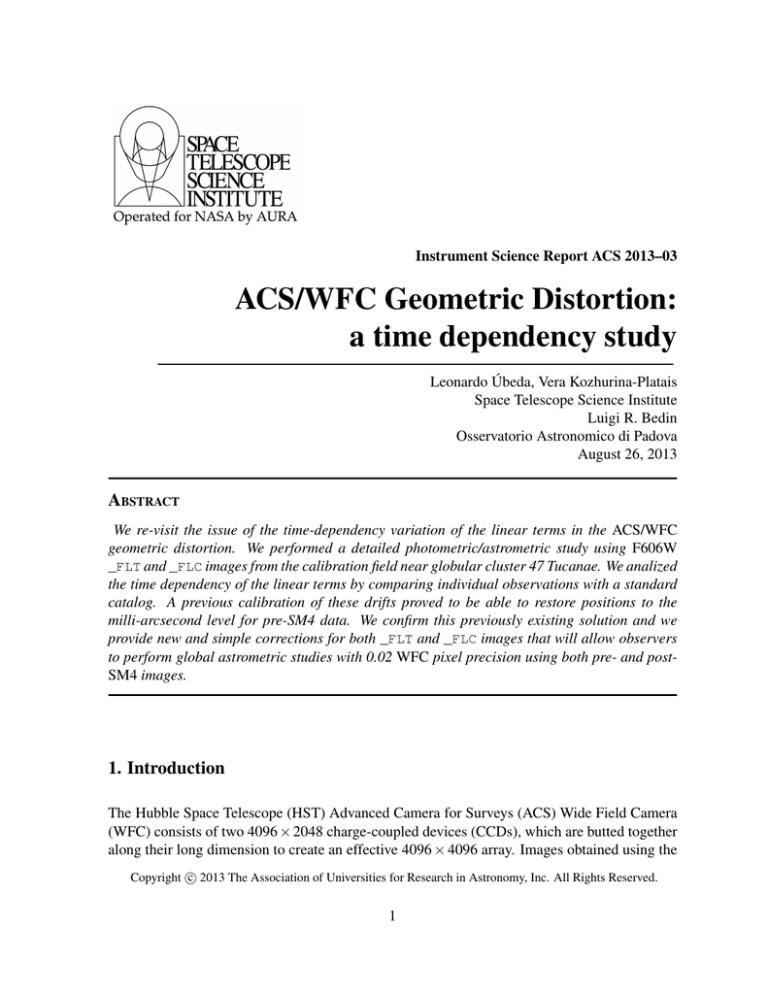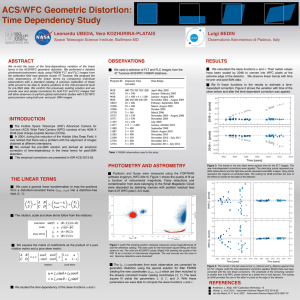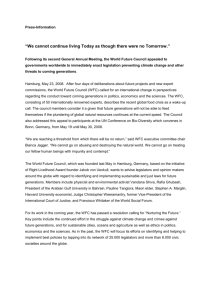
Instrument Science Report ACS 2013–03
ACS/WFC Geometric Distortion:
a time dependency study
Leonardo Úbeda, Vera Kozhurina-Platais
Space Telescope Science Institute
Luigi R. Bedin
Osservatorio Astronomico di Padova
August 26, 2013
ABSTRACT
We re-visit the issue of the time-dependency variation of the linear terms in the ACS/WFC
geometric distortion. We performed a detailed photometric/astrometric study using F606W
_FLT and _FLC images from the calibration field near globular cluster 47 Tucanae. We analized
the time dependency of the linear terms by comparing individual observations with a standard
catalog. A previous calibration of these drifts proved to be able to restore positions to the
milli-arcsecond level for pre-SM4 data. We confirm this previously existing solution and we
provide new and simple corrections for both _FLT and _FLC images that will allow observers
to perform global astrometric studies with 0.02 WFC pixel precision using both pre- and postSM4 images.
1. Introduction
The Hubble Space Telescope (HST) Advanced Camera for Surveys (ACS) Wide Field Camera
(WFC) consists of two 4096 × 2048 charge-coupled devices (CCDs), which are butted together
along their long dimension to create an effective 4096 × 4096 array. Images obtained using the
c 2013 The Association of Universities for Research in Astronomy, Inc. All Rights Reserved.
Copyright 1
ACS/WFC suffer from strong geometric distortion: the square pixels of its detectors project on
the sky as parallelograms.
High-precision astrometry with HST could be achieved with an accurate modeling of this geometric distortion. The original studies involving the ACS/WFC were performed by Meurer
et al. (2002) and Anderson (2002). Both papers show that the distortion of the ACS/WFC
detectors is highly non-linear and that a fourth order polynomial is adequate for characterizing
the distortion to an accuracy better than the 0.2 pixel requirement. A look-up table for each
filter is requiered to achieve 0.01 WFC pixel accuracy
In 2004, during reduction of the Hubble Ultra Deep Field, it was noticed that there was a
problem with the alignment of images obtained at different orientations. This led to the discovery that the linear terms in the distortion solution have changed monotonically since ACS
was installed in 2002. An empirical time-dependent correction for these drifts was found by
Anderson (2007) using hundreds of ACS/WFC images of the calibration field of 47 Tucanae
obtained between 2002 and 2006. Anderson (2007) produced an accurate 47 Tucanae reference frame with a nominal scale of 0.050 "/pixel, as well as an improved master source catalog
(ALLSTAR.RIGID.XYM) with ∼ 53 000 sources found in the field.
Soon after Servicing Mission 4 (SM4, which took place on 12 May 2009), it was realized that
the behaviour of the linear terms derived in Anderson (2007) might no longer be valid for
post-SM4 data.
The goal of this Instrument Science Report is to revise the pre-SM4 linear terms of the ACS/WFC
distortion solution using both _FLT and _FLC images and to derive an empirical correction of
time-dependency in the linear terms for post-SM4 distortion.
2. The Linear Terms
The standard astrometric procedure to examine the accuracy of the geometric distortion is to
compare the position of stars corrected for distortion on a measured frame with the positions of
the same stars in a distortion-free reference frame. The residuals between the observed positions
of stars and the corresponding positions in the astrometric standard catalog reveal the accuracy
of the distortion. For the present work, we adopt the catalog ALLSTAR.RIGID.XYM derived by
Anderson (2007).
According to Anderson (2007), to map the positions from a distortion-corrected frame (xcorr , ycorr )
into a distortion-free astrometric flat-field (X , Y) one could use a linear transformation with six
parameters as the following:
xcorr − x◦
X◦
X
A B
=
×
+
Y
C D
ycorr − y◦
Y◦
2
(1)
where A, B,C, D are the coefficients from the linear transformation that are used to calculate
the average rotation angle (θ), the average scale of the transformation (s), and two skew terms
(ζ1 , ζ2 ), by the following relations:
tan(θ) = (B −C)/(A + D)
√
A D − BC
s =
ζ1 = (A − D)/2 s
ζ2 = (B +C)/2 s
(2)
For each star present in both the master catalog and an individual distortion-corrected frame we
have two pairs of coordinates [(xcorr , ycorr ) ; (X , Y)]. For an observation with N stars found in
the image and in the master catalog, the list [(xcorr , ycorr ) ; (X , Y)]i=1,...,N can be used to solve
for the parameters in the linear transformation [A, B,C, D, X◦ , Y◦ ] using a linear least-squares fit
(see Equation 2 in Anderson (2007)).
According to van der Marel et al. (2007), the skew terms ζ1 and ζ2 do not separate two effects:
neither the difference in scale nor the non-perpendiculartity between axes. These effects are due
to the fact that the skew in one frame can manifest itself as either ζ1 or ζ2 or both, depending on
the rotation angle θ between the frames. Thus, we adopt the quantities u and v defined as:
A B
cos θ sin θ
1+v u
= s×
×
C D
− sin θ cos θ
u 1−v
(3)
i.e., (provided that u, v 1) the original matrix of coefficients can be expressed as the product
of a pure rotation matrix and a pure skew matrix. Inverting the matrix, these new quantities u
and v can be written as functions of the derived parameters A, B,C, and D with:
u = ζ1 sin θ + ζ2 cos θ
v = ζ1 cos θ − ζ2 sin θ
(4)
These quantities better disentangle the two effects of difference in scale (v 6= 0), and departure
from orthogonality (u 6= 0) between the two axes. In other words, how much a square is transformed into a rectangle (v 6= 0), or into a rhombus (u 6= 0) or into a combination of both resulting
in a parallelogram (u 6= 0 and v 6= 0).
The skew terms u and v were parametrized as linear variations with time by Anderson (2007)
using the quantities α and β which relate to u and v with the following relationships:
α = 2048 × u
β = 2048 × v
3
(5)
3. Observations
The main calibration field for our study is located about 6.7 arcmin West of the center of
globular cluster 47 Tucanae. This calibration field has been observed multiple times through
many ACS/WFC filters for both calibration and science purposes. Using the Mikulski Archive
for Space Telescopes (MAST), we downloaded the entire database of 47 Tucanae ACS/WFC
F606W observations with exposure times longer than 200 seconds. In Table 1 we list each HST
Program ID for these images, together with their exposure times and the range of dates of the
observations. In summary, we used 272 images.
The automated calibration pipeline CALACS (version 8.0.6, 18 Jul 2012) takes care of the basic
data reduction (bias, dark, flat–field corrections). We downloaded the flat–fielded images (_FLT
files), as well as the charge-transfer efficiency (CTE) corrected images (_FLC files). The _FLC
files are data products generated using the pixel–based CTE correction algorithm (PixelCTE
v3.2; Anderson & Bedin (2010)).
Program ID
Exposure Time
(seconds)
Date Range
9018
9433
9648
9656
10043
10368
10569
10730
10737
10771
11397
11677
11880
11887
12385
12389
12730
12734
690 720 765 765 1200
10 × 340
15 × 400 + 4 × 1100
200 240 360 420 450
24 × 400
24 × 400
4 × 340
3 × 340
10 × 339
12 × 339
14 × 339
117 × ∼1400
5 × 400
2 × 339
6 × 400
3 × 339
6 × 400
3 × 339
April–May 2002
January–February 2003
January–August 2003
November 2002 – August 2003
February–September 2004
March–August 2005
October 2005
March 2006
November 2005 – August 2006
November 2005
July 2009
January–October 2010
September 2009
March–August 2010
November 2010
November 2010 – July 2011
November 2011
December 2011– July 2012
Table 1: F606W observations used in this study.
4
4. Method
4.1 Photometry and Accurate Source Positions
Positions and fluxes of point sources were accurately measured with the FORTRAN software
img2xym_WFC.09x10 in the library of codes by J. Anderson. This code includes the best
available geometric distortion solution and is documented and described in detail in Anderson
& King (2006).
PSF-fitting photometry was performed
on all _FLT and _FLC images listed in
Table 1 using library PSFs described
in Anderson & King (2006). For each
image, this task produces an _xym file
containing: each source position in
the image frame (x, y), its instrumental magnitude, and a quality of fit value
(qfit).
The fluxes are corrected for pixel area
and converted into instrumental magnitudes (−2.5 log(flux)) where the flux
is given in units of electrons.
Figure 1 shows the quality of fit
(qfit) as a function of instrumental
magnitude of all the sources found in
image j9irw4azq with exposure time
of 339 seconds. Note the presence of
Figure 1: Typical photometry plot showing the quality of the false detections such as cosmic rays and
PSF fit as a function of instrumental magnitude. The real sources hot pixels with qfit> 0.2 − 0.3.
are the ones with lower value of qfit. In the text we describe
how spurious detections were discarded.
We performed our analysis in both
_FLT and _FLC images because of
the known effect that imperfect charge
transfer in CCDs has upon centroid shifts; see for example Kozhurina-Platais et al. (2007).
4.2 Solving for Linear Terms
The next step is to cross-identify the stars in each exposure’s _xym file with the stars in the
master catalog with coordinates (X , Y). To do this, we used a pattern-matching algorithm that
matches pairs of coordinates in two lists based on triangles that can be formed from groups of
three points in each list.
5
The (x, y) coordinates from each observation are corrected for geometric distortion using the
special solution for filter F606W yielding the new coordinates (xcorr , ycorr ) which are then matched
to the already corrected master catalog coordinates (X , Y). The distortion solution used for this
has no time dependency in its skew terms.
This process provides a first approximation linear transformation that includes all the matched
stars, including false detections matched with real reference frame stars. The left panel in
Figure 2 shows an example residual plot for image j9irw4azq_flt.
Two groups of stars are clearly seen in this plot. The group in the center contains stars that
are members of 47 Tucanae. The off-centered group corresponds to Small Magellanic Cloud
(SMC) stars. This separation is caused by the observed proper motion of the 47 Tucanae globular cluster relative to that of the SMC. This effect is also described in Kozhurina-Platais et
al. (2009). In order to have a clean sample of stars for our study, we only selected sources
that are from 47 Tucanae and that had position residuals less than 0.07 WFC pixel (∼ 3.5 mas)
in radius. Those objects are shown in red. Their corresponding photometry is presented in the
right panel in Figure 2. This procedure allows us to reject false detections like cosmic rays and
hot pixels, as well as non-members of the cluster. The final star selection is thus very clean and
reliable.
Figure 2: [Left] Plot showing position residuals measured using image j9irw4azq_flt and the reference
catalog. The stars used for the final least–square fitting are those shown in red. The units are ACS/WFC pixels.
[Right] Same as Figure 1, with the same color coding as in the left panel.
We refined our solutions for the parameters A, B,C, and D by running the least square fit a
second time on _FLT and _FLC images using only the selected stars within a radius of 0.07
WFC pixels. With these parameters we were able to compute the values of the skew terms
defined in Equation 4.
6
5. Analysis and Results
Using the estimated parameters A, B,C, and D we calculated the skew terms (u and v) according
to Equation 4. Figure 3 shows the skew terms as a function of time. Their radian values have
been scaled by 2048 to convert into WFC pixels at the extreme edge of the detector. The
values shown were derived from the _FLT images; very similar results were derived from the
_FLC images. The dark-blue points represent pre-SM4 observations and the light-blue points
represent post-SM4 images. This applies to all Figures in this ISR.
Both sets of points show a linear trend with time. This is a known result that was already found
by Anderson (2007) and van der Marel et al. (2007) for the pre-SM4 data. We fit a simple
linear function to the data and found the solution given in Equation 6:
FLT images
2048 · u(time) = 0.095 + 0.088 × (time − 2004.5)/2.5
2048 · v(time) = −0.028 − 0.034 × (time − 2004.5)/2.5
(6)
where time is expressed in units of years.
This fit represents the pre-SM4 trend very well and is in agreement with the previous work by
Anderson (2007). We fit a similar function to the u and v pre-SM4 values obtained using _FLC
images, and the new simple corrections are given in Equation 7.
FLC images
2048 · u(time) = 0.092 + 0.088 × (time − 2004.5)/2.5
2048 · v(time) = −0.024 − 0.030 × (time − 2004.5)/2.5
(7)
Post-SM4 data show a similar trend but are clearly displaced by the time that the ACS was out
of service since January 2007 (camera failure) through May 2009 (Servicing Mission 4).
We fit the post-SM4 data obtained with both the _FLT and _FLC images and the new solutions
for u and v as a function of time are given by Equations 8 and 9.
FLT images
2048 · u(time) = 0.229 + 0.070 × (time − 2011.0)/2.0
2048 · v(time) = −0.088 − 0.044 × (time − 2011.0)/2.0
(8)
FLC images
2048 · u(time) = 0.230 + 0.070 × (time − 2011.0)/2.0
2048 · v(time) = −0.074 − 0.037 × (time − 2011.0)/2.0
(9)
In order to verify our method and the new post-SM4 set of corrections, we solve the linear system in Equation 1 on the _FLT images again, but this time we turn on the skew time-dependency
7
Figure 3: The trends in the two skew terms against time. No time-dependent correction applied. The dark-blue
points represent pre-SM4 observations and the light-blue points represent post-SM4 images. The scaling by 2048
provides the size of the effect in pixels at the edge of the detector.
correction as shown in Equations 6 and 8. The corrected u and v values are presented in Figure 4. For comparison, we over plotted the un-corrected observations using gray points. The
time-dependent skew corrections flatten the distributions. Both post-SM4 and pre-SM4 timecorrected data show no trend whatsoever. The skew terms u and v calculated for images observed in 2012 show similar values as those estimated for images observed close to the ACS
installation in 2002.
In Figure 5 we present the skew terms ζ1 and ζ2 (in units of WFC pixels) as a function of
time. The left panels show the results obtained for the _FLT images with no time-dependent
correction. The plots on the right side show ζ1 and ζ2 after the linear correction was applied.
These residual terms show some variations with time, but the amplitude of this variation is very
small (less than 0.02 WFC pixel) compared to what was seen before the correction (0.3 pixel).
We also analyzed possible variations of the skew terms as a function of the telescope roll-angle,
as specified by the image header keyword PA_V3. In this analysis we have adopted the definition
for the skew term given by Kozhurina-Platais & Petro (2012) as in Equation 10
8
Figure 4: The trends in the two skew terms against time for _FLT images. The new time-dependent corrections
were applied. The dark-blue points represent pre-SM4 observations and the light-blue points represent post-SM4
images. Gray points represent the original un-corrected data. It is shown to aid the eye in the comparison. The
scaling by 2048 provides the size of the effect in pixels at the edge of the detector.
tan(γ) = −
AB +CD
AD −CB
(10)
When no correction is applied, the left panel in Figure 6 shows a clear sinusoidal trend with
large amplitude of γ, up to as much as 60". However, if the skew time-dependent correction is
applied, then the skew shows no trends and varies by at most 5".
9
Figure 5: The trends in the two skew terms: ζ1 [Above] and ζ2 [Below] against time for _FLT images. [Left] No
time-dependent correction applied. [Right] Data has been corrected with the new linear corrections. The amplitude
of the remaining variation is smaller than 0.02 WFC pixels (shown as a dotted line in both figures). The scaling by
2048 provides the size of the effect in pixels at the edge of the detector.
6. Conclusions
We re-visit the problem of the time dependency of the linear terms in the ACS/WFC geometric
distortion. The first solution to this problem was provided by Anderson (2007) and it only
applied to pre-SM4 _FLT images.
We performed a study of the variability of the linear terms of the distortion of the ACS/WFC
CCDs using the calibration field close to the center of globular cluster 47 Tucanae. We extended
the study to post-SM4 observations and we analyzed both _FLT and _FLC F606W images. We
provide new and simple corrections that will allow observers to perform global astrometric
studies with 0.02 WFC pixel precision.
10
Figure 6: Skew (γ) in arcsec as a function of the parameter PA_V3 which is recorded as a science header keyword.
[Left] No time-dependent correction applied. [Right] Data has been corrected with the new linear corrections. The
amplitude of the remaining variation is smaller than 5 arcsec (shown as a dotted line in both figures).
The corrections are presented as linear functions of the form:
2048 · u(time) = u1 + u2 × (time − t0 )/u3
2048 · v(time) = v1 + v2 × (time − t0 )/v3
(11)
where time is the date of the observation expressed in years, t0 is an arbitrary parameter equal
to 2004.5 for pre-SM4 data and 2011.0 for post-SM4 data. The coefficients u1 , u2 , v1 , v2 and
their errors are listed in Table 2. The coefficients u3 and v3 are also fixed and equal to 2.5 and
2.0 for pre-and post-SM4 data respectively. The scaling by 2048 provides the size of the effect
in units of WFC pixels at the edge of the detector.
We also studied possible variations of the skew as a function of the telescope roll-angle and
found that the new corrections completely erase a sinusoidal trend found when no time-correction
is applied.
11
u1
u2
v1
v2
Pre-SM4 observations
FLT
FLC
0.095 ± 0.004 0.088 ± 0.002 −0.028 ± 0.001
0.092 ± 0.001 0.088 ± 0.001 −0.024 ± 0.001
−0.034 ± 0.002
−0.030 ± 0.001
Post-SM4 observations
FLT
FLC
0.229 ± 0.001 0.070 ± 0.002 −0.088 ± 0.001
0.230 ± 0.001 0.070 ± 0.002 −0.074 ± 0.001
−0.044 ± 0.002
−0.037 ± 0.002
Table 2: Values of the coefficients in the linear functions in Equation 11.
Acknowledgments
The authors would like to thank N. Grogin and J. Anderson for their comments and revision
suggestions that resulted in an improvement of this work. The authors acknowledge very helpful
conversations with N. Dencheva and W. Hack. Finally, we are grateful to J. Anderson for
providing access to his suite of FORTRAN algorithms.
References
Anderson, J. 2002, HST Calibration Workshop: Hubble after the Installation of the ACS and the
NICMOS Cooling System, 13
Anderson, J., & King, I. R. 2006, Instrument Science Report ACS 2006–01
Anderson, J. 2007, Instrument Science Report ACS 2007–08
Anderson, J., & Bedin, L. R. 2010, PASP , 122, 1035
Kozhurina-Platais, V., Goudfrooij, P. & Puzia, T. H. 2007, Instrument Science Report ACS 2007–04
Kozhurina-Platais, V., Cox, C., McLean, B., et al. 2009, Instrument Science Report WFC3 2009–33
Kozhurina-Platais, V., & Petro, L. 2012, Instrument Science Report WFC3 2012–03
Meurer, G. R., Lindler, D., Blakeslee, J. P., et al. 2002, HST Calibration Workshop: Hubble after the
Installation of the ACS and the NICMOS Cooling System, 65
van der Marel, R. P., Anderson, J., Cox, C., et al. 2007, Instrument Science Report ACS 2007–07
12








